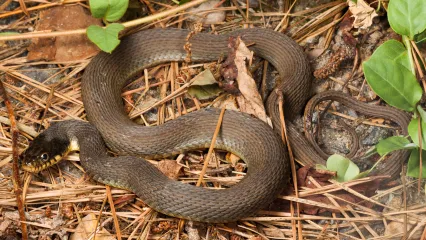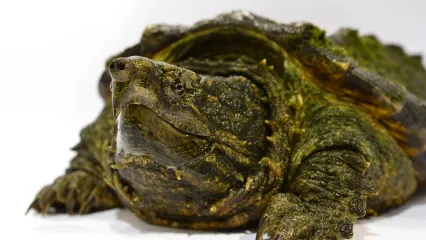
Description
Southern coal skinks are small to medium-sized lizards with smooth, glass-like scales, four well-developed limbs, and a tail that is slightly longer than the body. Adults are dark tan in coloration, with a broad and nearly black stripe on each side of the body extending from the back of the head to the first one-third of the tail. The dark stripe is three to four scales wide and is bordered above and below by thin white or cream-colored stripes. Juveniles are nearly all black and have dark blue tails. Although adults can be confused with adult five-lined skinks that have lost their three dorsal stripes, bellies of southern coal skinks are usually dark whereas bellies of five-lined skinks are light colored. Although sometimes difficult to see, close examination of the scales under the head distinguishes southern coal skinks from other skinks. Southern coal skinks have only one postmental scale whereas other skinks have two.
Size
Large adult southern coal skinks can reach just over two and one-half inches in snout to vent length and five to six inches in total length. Females are slightly larger than males. Many individuals have regenerate tails so that the ratio of tail to body length is reduced.
Habitat
In North America, the west-east distribution of coal skinks extends from eastern Oklahoma to western Pennsylvania and north-south from Pennsylvania to the Florida panhandle. However the distribution is not continuous.
Life Cycle
Southern coal skinks are strictly terrestrial and diurnal, and in Oklahoma, are associated with mesic areas in hardwood forests. Activity occurs from February through November, depending on local climatic conditions and these skinks are active earlier in the year than most other skinks. Mating occurs in early spring and females deposit clutches of 7-13 eggs most likely in late May and June. The number of eggs produced by females depends on size of the female; larger females produce more eggs than smaller females. Females presumably remain with the eggs until they hatch in August or early September, and presumably not post-hatching parental care exists as in other related skinks. Hatchlings are about one inch in snout to vent length. Southern coal skinks feed primarily on arthropods including grasshoppers, crickets, caterpillars, and spiders.
How To Observe
Similar to some other skinks, southern coal skinks are difficult to observe in the field. They can be seen foraging in leaf litter and on the ground in mesic areas of hardwood forests during early spring or late fall.
(This profile was created by Dr. Laurie Vitt as part of a partnership between the Wildlife Department and the Sam Noble Oklahoma Museum of Natural History. It was funded as part of a larger State Wildlife Grant to survey and inventory amphibians and reptiles of the Wildlife Management Areas of Oklahoma: T-35-P-1.)


